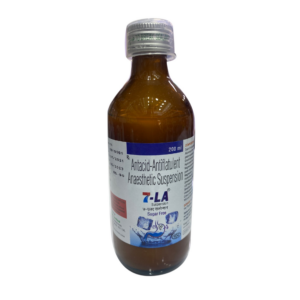SIMETHICONE + MAGNESIUM HYDROXIDE + ALUMINIUM HYDROXIDE + OXETACAINE
Simethicone: Simethicone is a medication commonly used for the treatment of symptoms related to excessive gas in the gastrointestinal tract, such as bloating, belching, and abdominal discomfort.
The mechanism of action of simethicone is not completely understood, but it is believed to work by breaking down the surface tension of gas bubbles, allowing them to combine and be expelled more easily. This reduces the bloating and discomfort associated with excess gas.
Simethicone is available over-the-counter and comes in various forms, including tablets, capsules, chewables, and liquids. The recommended dose varies depending on the product and the individual’s age. It is typically taken after meals and at bedtime, and it should be used as directed on the package or as instructed by a healthcare professional.
As an over-the-counter medication, simethicone is generally considered safe and well-tolerated. It has few reported side effects, but some individuals may experience mild gastrointestinal symptoms such as nausea or diarrhea. These side effects are typically rare and not severe.
Simethicone is generally safe for most people, but it is important to talk to a healthcare professional before starting any new medication, especially if you have any underlying medical conditions or are taking other medications. They can provide you with personalized dosing instructions and advice specific to your situation.
Magnesium Hydroxide: Magnesium hydroxide is a medication commonly used as an antacid and a laxative. It is often sold under brand names such as Milk of Magnesia or Phillips’ Milk of Magnesia.
As an antacid, magnesium hydroxide helps neutralize excess stomach acid and provides relief from symptoms of heartburn, acid indigestion, and upset stomach. As a laxative, it helps promote bowel movements and relieve occasional constipation.
The mechanism of action of magnesium hydroxide as an antacid is based on its ability to react with stomach acid, forming magnesium chloride and water. This neutralizes the excess acid, reducing the discomfort associated with acid reflux and indigestion.
As a laxative, magnesium hydroxide attracts water into the intestines, which softens the stool and promotes bowel movement. It can take 6 hours to 12 hours for the laxative effect to occur.
The recommended dose of magnesium hydroxide as an antacid is typically 500 mg to 1500 mg, taken orally as needed. As a laxative, the usual dose is 2 to 4 tablespoons (30-60 ml) taken orally once daily or as directed by a healthcare professional. It is important to carefully follow the dosing instructions provided by your healthcare provider or as indicated on the product packaging.
While generally considered safe, magnesium hydroxide may cause some side effects. These can include diarrhea, abdominal cramps, and nausea. If these side effects persist or become severe, it is important to consult a healthcare professional. Additionally, it is important to inform your healthcare provider about any medical conditions or medications you are taking, as magnesium hydroxide can interact with certain medications and may not be suitable for individuals with kidney problems or other specific conditions.
Aluminium Hydroxide: Aluminium Hydroxide is an antacid often used to relieve symptoms of heartburn, indigestion, and upset stomach. It works by neutralizing excess stomach acid and preventing the formation of ulcers.
The typical dose of aluminium hydroxide is 800-1600 mg per day, taken orally in divided doses or as directed by a healthcare professional. It is important to follow the prescribed dosage and not exceed the recommended amount.
As for side effects, aluminium hydroxide is generally well-tolerated. However, some people may experience constipation, diarrhea, stomach cramps, or nausea. These side effects are usually mild and transient. Rarely, individuals may develop a condition called hypophosphatemia (low phosphate levels) with long-term use of aluminium hydroxide.
It is essential to consult a healthcare professional before taking aluminium hydroxide to ensure it is appropriate for your specific condition and to avoid any potential drug interactions.
Oxetacaine: Oxetacaine is a drug belonging to the class of local anesthetics. It is primarily used as a topical medication to numb the skin or mucous membranes in order to alleviate pain or discomfort.
The mechanism of action of oxetacaine involves blocking the transmission of pain signals by inhibiting the voltage-gated sodium channels present in the nerve endings. This action prevents the generation and propagation of nerve impulses, thereby providing temporary relief from pain.
Oxetacaine is available as a cream, gel, or spray and is typically applied directly to the affected area. The dose and frequency of application may vary depending on the specific condition being treated and the strength of the formulation. It is important to follow the instructions provided by the healthcare professional or the product label.
Common side effects of oxetacaine may include temporary numbness or tingling at the application site, skin irritation, redness, or rash. These side effects are usually mild and resolve on their own. However, if any severe or persistent side effects occur, it is recommended to seek medical attention.
It is important to note that oxetacaine is meant for external use only and should not be ingested or applied to broken or irritated skin. It is also advisable to avoid using oxetacaine on large areas of the body, as it may lead to systemic absorption and systemic side effects. Prior to using oxetacaine, it is recommended to inform a healthcare professional about any pre-existing medical conditions or allergies, as well as any concurrent medications being taken.

